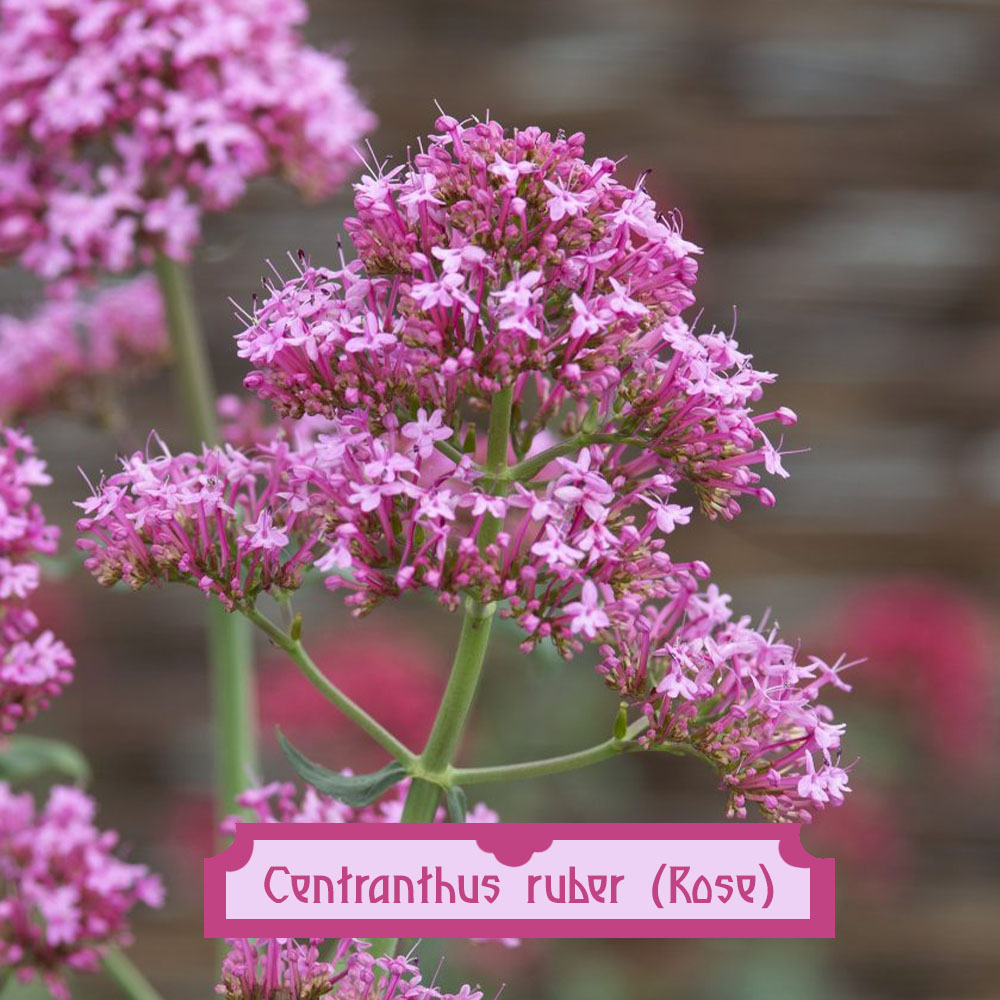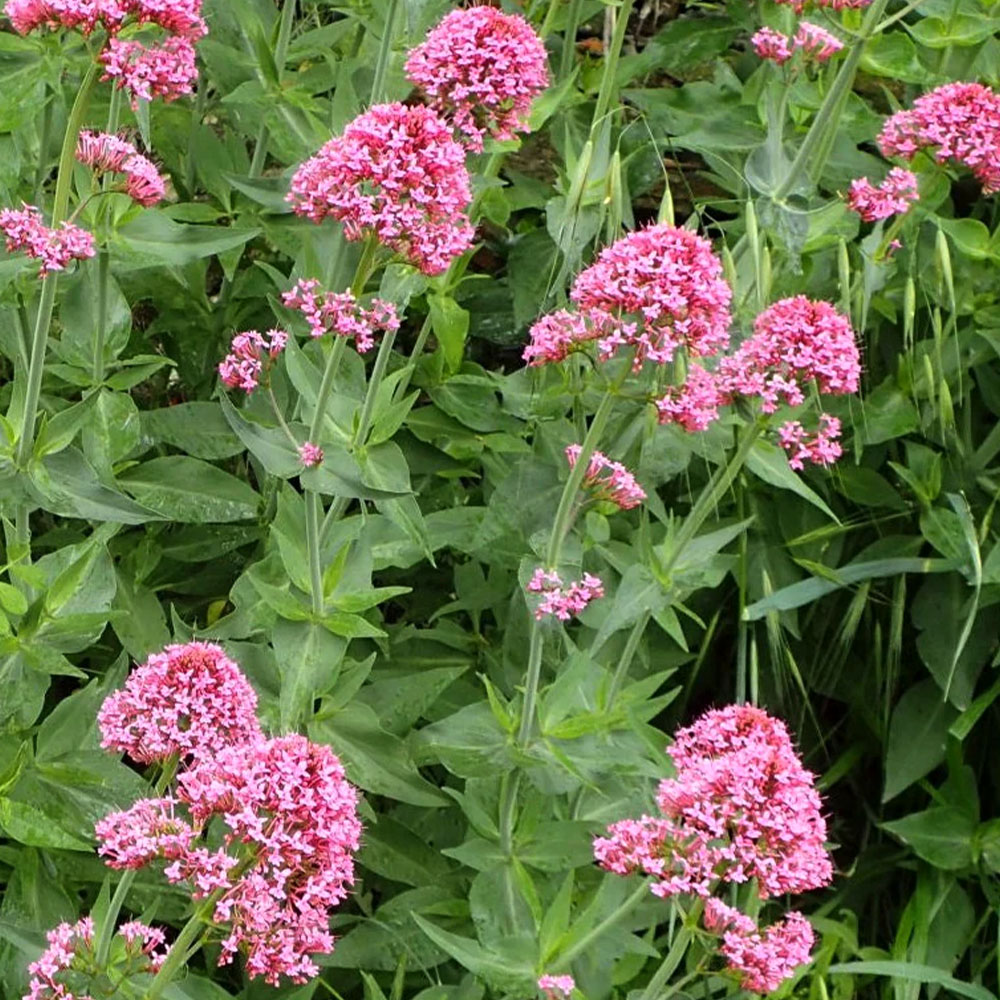No products in the cart.
Centranthus ruber Roseus
A variation on the valerian theme – with soft pink flowers
Rated 0 out of 5
0 customer reviews
4,90 €
Only 23 item(s) left in stock!
Tags: chaud, comestible, couleur, feuillage persistant, graphique, perennial, persistant, plant, potted plant, secheresse, soleil, vivace, vivace en pot, xeriscaping
SKU: pda334-1
Category: Bees and Butterflies, Bouquet, Fragrant, Frost Hardy, Make it Pop, Rewild

Centranthus ruber Roseus
4,90 €
Only 23 item(s) left in stock!
Centranthus ruber Roseus is a wonderfully resilient perennial, producing fragrant, rose colored flowers all throughout the summer.
The flowers are large, fragrant and of a soft pastel pink color. Flowering takes place in early summer but will continue sporadically in cool summer areas, sometimes all the way into the fall.
The leaf form changes from the bottom to the top of the plant but is basically oval shaped. The lower leaves are petiolate (with stalk) while the upper leaves are sessile (without stalk).
The foliage is deciduous – it will dry out in autumn and return with panache the following spring.
It grows in poor soil, high sun, dry environments and rock gardens – really a perfect partner!
👨🌾GARDENING TIPS👨🌾: Centranthus ruber Roseus
-
- ⚠️The seeds have tufts, similar to dandelions, allow for wind dispersal, and as such can self-seed freely and become invasive if not properly controlled.
- To curtail the invasion, cut off the faded flowers before the plants to seed.
- 🌼This is what allows for it to peek through cracks and grow in old stone walls ( this is due to its ability to tolerate alkaline conditions and lime in mortar).
- ⚠️The seeds have tufts, similar to dandelions, allow for wind dispersal, and as such can self-seed freely and become invasive if not properly controlled.
The Tale: Centranthus ruber Roseus
Centranthus roseus, commonly known as red valerian or Jupiter’s beard, is a charming, semi-evergreen perennial that brings informal, cottage-garden beauty to any setting.
It forms upright, bushy clumps typically reaching 60 to 90 centimeters in height, with narrow, grey-green leaves that are slightly hairy and aromatic, adding subtle texture and fragrance to the planting.
Floral Morphology
From late spring through early autumn, Centranthus roseus produces clusters of star-shaped flowers in shades of pink, deep red, or occasionally white.
These delicate blooms attract a wide range of pollinators, including bees and butterflies, making the plant a valuable addition to wildlife-friendly gardens.
Each flower cluster creates a soft, airy display that persists for weeks, providing long-lasting color when many other perennials have finished flowering.
Ecology
Red valerian thrives in well-drained soil and prefers full sun, though it tolerates light shade. It is drought-tolerant once established and grows well in poor or rocky soils, making it ideal for borders, walls, slopes, or dry gardens.
The plant can also self-seed, gently spreading to form naturalistic drifts or cascades over walls, enhancing its informal charm.
With its low maintenance, extended flowering period, and appeal to pollinators, Centranthus roseus is a versatile and reliable choice for adding color, texture, and movement to both traditional and naturalistic gardens.
Other Names:
Valerian
Origin:
Mediterranean
| Weight | 0,5 kg |
|---|---|
| Flower Color | 🩷 Pink |
| Flowering | July, August, September |
| Exposure | Full Sun |
| Frost Tolerance | -15°C to -20°C |
| Soil | Dry, Well-Draining |
| Size | 0.8m H x 0.4m W |
Reviews
0
Rated 0 out of 5
0 customer reviews
5
0
4
0
3
0
2
0
1
0
Only logged in customers who have purchased this product may leave a review.
You may also like…
Chrysanthemum Mei Kyo
A perennial with pink double pom-pom flowers
A perennial with pink double pom-pom flowers
Rated 0 out of 5
Verbena bonariensis
Long stalks with light, floating purple specks that attract bees
Long stalks with light, floating purple specks that attract bees
Rated 0 out of 5
Leucanthemum x superbum Brightside
A bushy perennial that produces an explosion of large white flowers
A bushy perennial that produces an explosion of large white flowers
Rated 0 out of 5
Related Products
Achillea ptarmica Boule de Neige
White pompom flowers to attract bees to your garden all summer long.
White pompom flowers to attract bees to your garden all summer long.
Rated 0 out of 5
Vinca minor
Looping elegance and ability to form a low flowering ground cover
Looping elegance and ability to form a low flowering ground cover
Rated 0 out of 5
Delosperma cooperi
A dwarf perennial known for its vermillion colored flowers
A dwarf perennial known for its vermillion colored flowers
Rated 0 out of 5
Jacobaea maritima
A wooly white perennial plant from the Mediterranean region.
A wooly white perennial plant from the Mediterranean region.
Rated 0 out of 5
Erigeron kavinskianus
A daisy-like carpet of flowers
A daisy-like carpet of flowers
Rated 0 out of 5
Sedum album
A low, multi-color ground cover.
A low, multi-color ground cover.
Rated 0 out of 5
Billbergia nutans
A bromeliad featuring a three colored, striped flower
A bromeliad featuring a three colored, striped flower
Rated 0 out of 5
Artemisia alba subsp camphorata
A highly fragrant, grey-green bush.
A highly fragrant, grey-green bush.
Rated 0 out of 5
Glechoma hederacea
A sweet smelling ground cover, producing little blue flowers all summer long.
A sweet smelling ground cover, producing little blue flowers all summer long.
Rated 0 out of 5
Tanacetum densum subsp amani
A shrublet composed of soft, finely divided silvery gray-white leaves.
A shrublet composed of soft, finely divided silvery gray-white leaves.
Rated 0 out of 5
Solidago ‘Golden Shower’
Beautiful showers of yellow flowers
Beautiful showers of yellow flowers
Rated 0 out of 5
Artemisia vulgaris Oriental Limelight
Striking green and yellow variegated foliage.
Striking green and yellow variegated foliage.
Rated 0 out of 5
Satureja montana
A sweet smelling culinary herb from Europe
A sweet smelling culinary herb from Europe
Rated 0 out of 5
Tradescantia Blushing Bride
Gorgeous blushes of pink and white that appear in the coldest nights.
Gorgeous blushes of pink and white that appear in the coldest nights.
Rated 0 out of 5
Cerastium tomentosum var. columnae
A grey-green spreading ground cover from the mountains.
A grey-green spreading ground cover from the mountains.
Rated 0 out of 5
Echinops ritro
Tall, electric blue globe thistles
Tall, electric blue globe thistles
Rated 0 out of 5
Euphorbia myrsinites
Known for its draping form of silver-gray foliage and radiant blooms.
Known for its draping form of silver-gray foliage and radiant blooms.
Rated 0 out of 5
Mentha x piperita ‘Chartreuse’
A spicy mint, known for its use in the production of liqueurs and herbal teas.
A spicy mint, known for its use in the production of liqueurs and herbal teas.
Rated 0 out of 5
recent view product
Heuchera ‘Prince’
Wonderfully ruffled dark purple/black foliage
Wonderfully ruffled dark purple/black foliage
Rated 0 out of 5
Tanacetum vulgare Isla Gold
A bright yellow medicinal and fragrant perennial herb
A bright yellow medicinal and fragrant perennial herb
Rated 0 out of 5
Sedum “Weihenstephaner Gold”
A low-growing sedum with a thick, dependable dark-bronze/green foliage and prolific flowering cycle.
A low-growing sedum with a thick, dependable dark-bronze/green foliage and prolific flowering cycle.
Rated 0 out of 5
Monarda didyma
A perennial with unusual fire colored flowers and fragrant foliage
A perennial with unusual fire colored flowers and fragrant foliage
Rated 0 out of 5
Delosperma Hardy Hybrid
Especially developed to withstand cold temperatures, snow, fire and drought.
Especially developed to withstand cold temperatures, snow, fire and drought.
Rated 0 out of 5





















































There are no reviews yet.